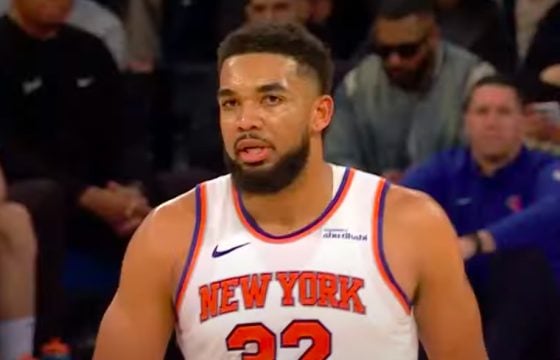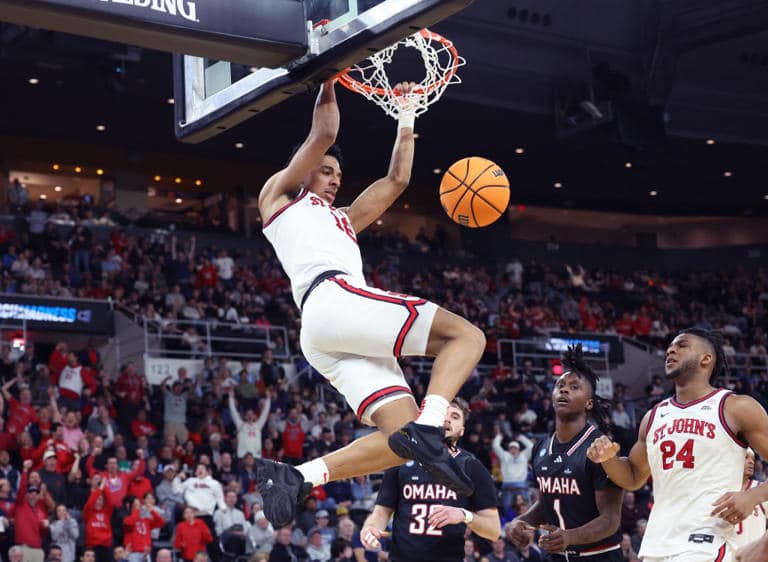As I sit here at 8 am on a Friday, contemplating the realization that Luka Doncic and Kyrie Irving stand in Boston’s way of a championship, I have two analogies running through my head.
The first is how WWE ran with ‘The Final Boss’ narrative leading up to WrestleMania, where The Rock returned from his sabbatical to insert himself into the Main Event Picture. The second is Jay-Z’s collaborative album with Linkin’ Park back in 2004, fittingly named Collison Course.
To me, both these analogies make sense. Kyrie Irving has been on a sabbatical from this stage. Since leaving the Cleveland Cavaliers, he’s had a Hollywood-worthy decline, leading to a wild glow-up that makes him the type of protagonist casual viewers love to eat up.
While Collison Course speaks to a team-up of Titans. At the time of release, Linkin’ Park was the biggest Nu Metal band on Earth (Sorry, Limp Bizkit, you still have a place in my heart.) Jay-Z was the biggest Hip-Hop star. That mash-up album still has its place on my playlist 20 years later. It was fun. It was different. It was two styles that people thought couldn’t mesh but found a way of co-existing in one space to become a dynamic pairing.
I thoroughly enjoyed this year’s WrestleMania. I’m a big wrestling fan. WWE & AEW are my jams.
And I played that Collision Course album until my CD was worn and battered. Now, certain songs live on several of my playlists. I am a Nu Metal kid at heart. An Elder-Emo, if you will.
But at the forefront of everything is basketball.
I’ve loved basketball since I was 7 years old.
I remember the last time the Celtics won a championship. I remember staying up late as a 21-year-old with no commitments. I remember being on my own at a stupid time in the morning, celebrating a win that no one around me would care about, celebrating the achievements of a team thousands of miles away. Things will be different next time, I hope.
Before discussing championship celebrations or parades, the Celtics have one final boss to overcome. And if computer games have taught us anything, it’s that you can never underestimate the resilience and un-relenting offense that awaits in that final battle. Fortunately, as I’ve done in every series leading up to this point, I will try and paint a picture of what the Celtics are up against.
Dallas: By the numbers
The Dallas Mavericks ended the regular season ranked 8th in the league for offensive rating, averaging 117 points per 100 possessions. They are 6th in the postseason, dropping an average of 115.2 points per 100. However, there’s somewhat of a different story on the defensive end.
In the regular season, the Mavericks were 18th in the league for defensive rating, allowing 114.6 points per 100. In the playoffs, they’re 7th, with 111.1 per 100. PJ Washington’s addition has helped bring balance to their defensive system. And Maxi Kleber’s return from injury will also pay dividends.
The Mavericks’ defense is better than many give it credit for. However, they’ll be tested when facing Boston. Their ability to guard 1-through-5, when everyone can put the rock on the floor, score off the dribble or off the catch, and create for others, will be the biggest test of Dallas’ defensive credentials. If Kristaps Porzingis is back in the Celtics rotation, dealing with Boston’s spacing will also be another significant test.
One thing the Mavericks can’t do, is allow themselves to be drawn into a shoot-out against the Celtics. Becuase Boston has too many weapons at their disposal.
The Celtics aren’t a team you want to get into a shootout with — they’re just as talented on offense but have a far more dominant rearguard, which should prove to be the difference maker.
I wrote this quote when breaking down the Eastern Conference Finals series against the Indiana Pacers. It remains true heading into the NBA Finals. The notable difference is the presence of Luka Doncic and Kyrie Irving — which we will get into later.
Let’s start peeling off some additional layers. All data, unless stated otherwise, is courtesy of Cleaning The Glass. I have stuck with regular-season data because it has a bigger sample size and paints a clearer picture.
:no_upscale()/cdn.vox-cdn.com/uploads/chorus_asset/file/25472085/2051572246.jpg)
Photo by Matthew J. Lee/The Boston Globe via Getty Images
Offensive Shot location frequency
This is where Dallas’ offense is coming from and how frequently they look to attack those spots. The higher the league ranking, the more frequently the Mavericks are attacking those spots vs. other teams in the league.
- Around the rim – 28.5%, 29th in the league
- Mid-Range – 30.6%, 18th in the league
- Short mid-range – 20.5%, 25th in the league
- Long mid-range, 10%, 8th in the league
- 3-Point range – 41%, 2nd in the league
- Non-Corner 3’s – 28.9%, 7th in the league
- Corner 3 – 12%, 1st in the league
Offensive Shot location accuracy
This is how accurately a team is shooting from each location on the court – the higher the league ranking, the better the Mavericks are at scoring in those areas.
- Around the rim – 71.2%, 2nd in the league
- Mid-Range – 45.3%, 9th in the league
- Short mid-range – 43.6%, 11th in the league
- Long mid-range, 46.1%, 9th in the league
- 3-Point range – 37.6%, 11th in the league
- Non-Corner 3’s – 38.1%, 6th in the league
- Corner 3 – 36.5%, 28th in the league
Putting that into context
The Mavericks are a perimeter-based team. They like to space the floor and take a high volume of shots from three-point range. They take and make a considerable amount of perimeter jumpers. The gravity and creation of Irving and Doncic creates open shooting opportunities elsewhere on the court. There’s a reason why they ranked 1st in corner threes throughout the regular season. Jason Kidd has them playing a spray offense while making reads out of doubles.
Dallas also projects to be a threat when attacking close-outs. They’re a top-10 team in long mid-range frequency and conversion. That becomes more prevalent in the postseason when the big is likely to be playing in drop rather than at the level of the screen. The Mavericks being so good at attacking close-outs forces a team to pick their position. You either run them off the line and live with the results in the mid-range, or you adjust your coverage and risk getting beaten to the rim.
Against the Pacers, the Celtics were content with allowing mid-range offense. They made a legitimate effort to minimize open threes and take away the rim. I would expect we see the same strategy against the Mavericks.
Joe Mazzulla won’t want Doncic or Irving getting downhill at will. As such, keeping a rim protector in drop may be the best option, as long as the gap help consistently pressures the ball-handler in space.
During the postseason, the Mavericks’ biggest weapon has been that corner three. They rank 1st in the playoffs for frequency and are hitting the shot at a 40% clip. When a team is hitting the corner shot so consistently, it puts pressure on the help defense. Because if you send help out of the corner, you’re getting punished when the rock is kicked out. Boston consistently uses corner help to provide rim protection from a roamer — usually Tatum.
Mazzulla may have to rethink that defensive principle if he doesn’t want to feed the Mavericks a steady diet of corner threes.
:no_upscale()/cdn.vox-cdn.com/uploads/chorus_asset/file/25472086/2051571750.jpg)
Photo by Matthew J. Lee/The Boston Globe via Getty Images
Defensive shot location frequency
This is where opposing teams look to generate their offense against the Mavericks’ defense – the lower the league ranking, the more frequently teams attack those spots.
- Around the rim – 31.6%, 11th in the league
- Mid-range – 32.1%, 24th in the league
- Short mid-rage – 22.7%, 18th in the league
- Long mid-range – 32.1%, 19th in the league
- 3-Point range – 36.4%, 14th in the league
- Non-Corner 3’s – 25.4%, 7th in the league
- Corner 3 – 10.8%, 24th in the league
Defensive shot location success rate
This is where opposing teams find success on offense – the lower the league ranking, the more successful teams are from those spots.
- Around the rim – 67.6%, 22nd in the league
- Mid-range – 43.1%, 14th in the league
- Short mid-rage – 43.9%, 16th in the league
- Long mid-range – 41.1%, 10th in the league
- 3-Point range – 37.5%, 19th in the league
- Non-Corner 3’s – 37.2%, 22nd in the league
- Corner 3 – 38.1%, 13th in the league
Putting that into context
Dallas’ limited three-point defense will be a real issue for them. The Celtics are first in the postseason for three-point frequency and first for non-corner three-point frequency. 43.7% of their total offense is coming from deep. In terms of conversion, Boston is seventh in the postseason for three-point percentage, hitting 37.2% and third in non-corner three percentage, hitting 38.6%.
The Celtics are also second in the playoffs for finishing at the rim, although they’re 15th for frequency. Nevertheless, the Celtics’ ability to force defensive collapses before finding open shooters on the perimeter will be a legitimate issue for Dallas. They can’t overreact to the Celtics’ gravity; otherwise, they will find themselves chasing shadows and defending in space, which is the worst place they want to be.
Another issue for the Mavericks will be their willingness to live with mid-range jumpers. The Celtics have embraced the middle of the court this season, with Brown and Tatum both thriving as mid-range assassins. The Celtics are shooting 43% on middies during the playoffs. If the Mavericks are going to let the Celtics shoot those shots, they will quickly find themselves scrambling for answers. Such is the beauty of being littered with three-level scorers in the rotation.
I will be interested to see how sturdy the Mavericks rim defense is, though. Both in terms of deterring attempts and impacting them when they occur. Boston will look to get downhill whenever possible. They’ve also started adding more corner drives into their offense, even getting Tatum some looks in those spots during the final stages of the ECF.
Overall, Dallas’ defense will be the primary swing factor in how long this series goes and who takes control. If the Mavericks can shore up their perimeter defense and pressure the mid-range without giving up coverage elsewhere, this will be a tough series. If they find themselves getting cooked on side-to-side actions around the horn, it’s going to be a tough run for them.
CelticsBlog graciously allowed this article to be cross-posted from my “Celtics Chronicle” newsletter.





